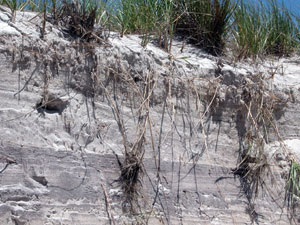 |
 | |
  | |
|
|
|
|
Fire Island National Seashore
Sand Dunes
|
|
|
|
|
| |
 |
|
Some of Fire Island's primary dunes east of Watch Hill are as high as 40 feet. Most of the primary dune line on the island, however, is much smaller. Behind many of the primary dunes lies a series of crescent-shaped secondary dunes, with a low interdunal swale in between.
Dunes are critical to the health and sustainability of sandy beaches. The primary dune ridge (foredunes) lies adjacent to the shoreline. Secondary dune fields may lie further inland. Dunes may form anywhere that eolian processes (wind transportation) occur.
Dunes provide much-needed protection to back-barrier environments (including human development) against severe wave, wind, and storm events. In addition, these geomorphic features provide critical habitat to a variety of migratory birds and mammals.
|
 |
| The rhizomes and rootlets of American beach grass help hold together the grains of sand that make up this eroded dune. |
 |
Dune vegetation is very important for the formation and stabilization of dune complexes on barrier islands. Both the root system and exposed vegetation restrict sand movement around plants, helping to secure the dune.
|
 |
| Beach grass sprout emerges from end of the plant's rhizome. |
 |
See More
Additional print-quality PDF images are available:
looking east, 8" x 6" print
, 8" x 6" print
with sand and rootlets, 8" x 6" print
Close-up of Sand and Beach Grass Rootlets, 8" x 6" print
, 4" x 3" print
, 4" x 3" print
Sand Fencing on Foredune, view from Robert Moses State Park looking toward Fire Island Lighthouse, 4 " x 3"
|
|  |  |
|
|

Barrier Island Dynamics
A constantly changing shoreline is one of the natural features of Fire Island.
more... | | 
Barrier Island Vegetation
Fire Island supports a variety of plants in its diverse habitats.
more... | |
|
|
|
|
|
|
|
 |
|
Did You Know?
New York's state gem—the garnet—may be found among the sands that comprise Fire Island's beaches. Due to differences in size and weight of the grains of sand, you may sometimes see ribbons of garnet and magnatite among the white quartz, as the sand settles on the beach.
more...
|
|
|
|
Last Updated: March 12, 2007 at 17:25 EST |






